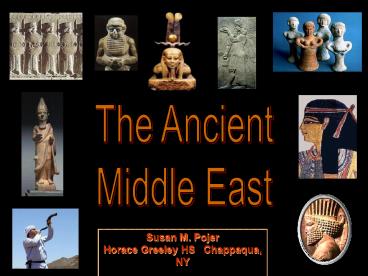Mesopotamia - PowerPoint PPT Presentation
1 / 32
Title:
Mesopotamia
Description:
Susan M. Pojer Horace Greeley HS Chappaqua, NY Additions by D. Brady The Fertile Crescent The word 'Mesopotamia' is in origin a Greek name (mesos `middle' and ... – PowerPoint PPT presentation
Number of Views:291
Avg rating:3.0/5.0
Title: Mesopotamia
1
The Ancient Middle East
Susan M. PojerHorace Greeley HS Chappaqua,
NY Additions by D. Brady
2
The Fertile Crescent
- The word 'Mesopotamia' is in origin a Greek name
(mesos middle' and 'potamos' - 'river' so land
between the rivers'). 'Mesopotamia' translated
from Old Persian Miyanrudan means "the fertile
cresent".
3
The Land Between Two Rivers
- Some of the best farmland of the Fertile Crescent
is in a narrow strip of land between the Tigris
and Euphrates Rivers. The Greeks later called
this region Mesopotamia, which means "between the
rivers." Many different civilizations developed
in this small region. First came the Sumerians,
who were replaced in turn by the Assyrians and
the Babylonians.
4
Indo-European Migrations 4m-2m BCE
The Middle East The Crossroads of Three
Continents
5
The Ancient Fertile Crescent Area
The Middle East The Cradle of Civilization
6
Mesopotamia does not refer to any particular
civilization. Over the course of several
millennia, many civilizations developed,
collapsed, and were replaced in this region
including the Sumerians -- Akkadians --
Babylonians and Assyrians.
7
Sumerians
8
The Sumerians
- The people who established the world's first
civilization around 3500 B.C. in southern
Mesopotamia were known as the Sumerians. - The Sumerians learned to control the Tigris and
Euphrates Rivers by constructing levees and
irrigation canals. As a result, a stable food
supply existed, and the Sumerian villages evolved
into self-governing city-states. - At the center of each city-state was a temple
surrounded by courts and public buildings.
Radiating from the all-important city center were
the two-story houses of the priests and
merchants, or the upper class the one-story
homes of government officials, shopkeepers, and
craftspeople and the lower class homes of
farmers, unskilled workers, and fishermen. The
city-state also included the fertile farming land
outside the city wall.
- Since there wasn't any building stone
- and very little timber in Sumer, the people
constructed their homes, public buildings, and
city walls out of sun-dried mud brick. - The Sumerians took great pride in their
city-states. Many times city-states would war
with each other because boundary disputes
existed. Sometimes a city-state would attack a
neighboring city-state just to prove its strength.
9
Sumerian Religion - Polytheistic
Enki
Innana
Anthropomorphic Gods
10
Mesopotamian Trade
The Cuneiform World
11
Cuneiform Wedge-Shaped Writing
12
Cuneiform
- As the Sumerian city-states' wealth increased,
government officials realized that an efficient
method of keeping records had to be developed.
Evolved from simple pictographic writing,
Sumerian cuneiform emerged as the world's first
writing system. The term cuneiform means
"wedge-shaped." It was made up of hundreds of
word signs that were "wedge-shaped" due to the
shape of the reed pen, or stylus, that was used.
The Sumerians wrote on clay tablets that would
either be dried in the sun or fired in kilns to
make the writing permanent.
13
Cuneiform Writing
14
Deciphering Cuneiform
15
Sumerian Scribes
Tablet House
16
Sumerian Cylinder Seals
17
Gilgamesh
- Gilgamesh is an ancient poem written in
Mesopotamia more than four thousand years ago.
The poem tells of a great flood that covers the
earth many years earlier, making it similar to
the story of Noah in the Old Testament of the
Jewish and Christian holy books. - Modern science has discovered that there was a
marked increase in the sea levels about 6,000
years ago as the last ice age ended. The melting
ice drained to the oceans causing the sea level
to rise more than ten feet in one century.
18
Gilgamesh
19
Gilgamesh Epic TabletFlood Story
20
The Ziggurat
- Originally the temples at the center of each
city-state were built on a platform. As time
passed, these platform temples evolved into
temple-towers called ziggurats. The ziggurat was
the first major building structure of the
Sumerians. Constructed of sun-baked mud bricks,
the ziggurats were usually colorfully decorated
with glazed fired bricks. - The ziggurat housed each city-state's patron god
or goddess. Only priests were permitted inside
the ziggurat as a result, they were very
powerful members of Sumerian society.
21
Ziggurat at Ur
- Temple
- Mountain of the Gods
22
The Royal Standard of Ur
23
Mesopotamian Harp
24
Board Game From Ur
25
Sophisticated Metallurgy Skillsat Ur
26
Sargon of AkkadThe Worlds First Empire
Akkadians
27
The Babylonian Empires
28
Hammurabi
- Hammurabi was the king of the city-state of
Babylon. About 1800BC, Hammurabi conquered the
nearby city-states and created the kingdom of
Babylonia. He recorded a system of laws called
the Code of Hammurabi. The 282 laws were engraved
in stone and placed in a public location for
everyone to see. Hammurabi required that people
be responsible for their actions. Some of
Hammurabis laws were based on the principle An
eye for an eye, a tooth for a tooth. This means
that whoever commits an injury should be punished
in the same manner as that injury. If someone put
out another persons eye, their eye would be put
out in return. Hammurabis Code may seem cruel
today, but it was an early attempt at law.
29
Hammurabis r. 1792-1750 B. C. E. Code
30
Hammurabi, the Judge
31
Babylonian Math
32
Babylonian Numbers































